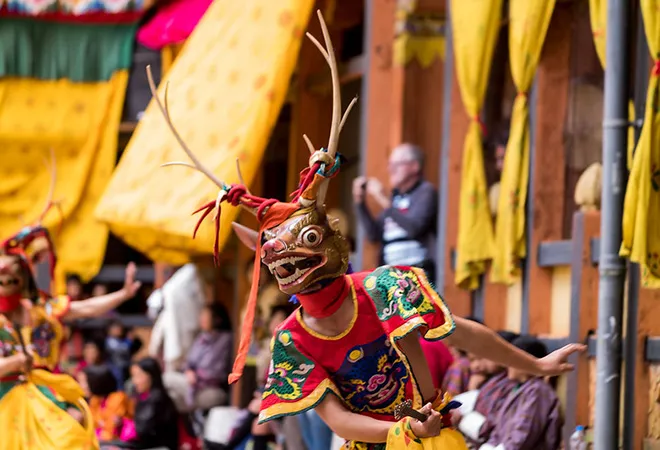
This article is part of the series — BIMSTEC in 2021.
Tourism is important to Bhutan, contributing about seven percent to the Gross Domestic Product. It is the second-highest revenue generator, highest foreign exchange earner, and the largest single sector employer in the country. Guided by the unique sustainable development philosophy of Gross National Happiness, tourism is pursued and practiced for objectives beyond revenue and receipt as envisioned by the tourism policy of ‘high-value, low volume.’ This policy is to avoid mass tourism, over-tourism , and to ensure a balance between economic returns and non-material gains such as preservation of the environment, culture, and history; thus, arrivals are guided by the carrying capacities of the various services and resources to ensure the wellness and well-being of the guests. Interestingly, what is being commonly referred to as the “new normal” amid COVID-19 is something that has been “normal” in Bhutan for the last 50 years. Therefore, Bhutan should confidently be able to share this experience with other countries.
High value, low volume tourism
The high-value, low volume tourism policy envisioned and promulgated by the Fourth King in the early 1970s envisages targeting mindful and responsible visitors, creating value for money experiences, operationalising a “less is more” economic model, and ensuring quality infrastructure, services, and tourism products. It ensures that the number of tourists arriving is consistent with the absorptive carrying capacity of the natural endowment, socio-cultural values, infrastructure, and services, and does not exacerbate vulnerabilities as a small nation. Adopting this policy amidst the immense pressure to embrace mass tourism for quick economic fortunes is a clear manifestation of far-sighted wisdom, a profound decision, and a deliberate resolution at a time when “sustainability and climate change” were just some terms without any associated agenda.
Over the years, Brand Bhutan continued to collect laurels and distinctions such as being the only carbon negative country in the world; a country whose development is guided by Gross National Happiness instead of Gross Domestic Product.
Over the years, Brand Bhutan continued to collect laurels and distinctions such as being the only carbon negative country in the world; a country whose development is guided by Gross National Happiness instead of Gross Domestic Product. Specifically, in tourism, Bhutan was recognised as the best country to visit in 2020 by Lonely Planet; best travel destination for happy tourism in 2020 by Pacific Area Travel Writers Association (PATWA); number one wellness destination on the rise in 2020 by Virtuoso; and best green country by Travel and Leisure India and South Asia Travel Magazine in 2020.
Bhutan and BIMSTEC
In an attempt to open its doors to cross-regional interaction, Bhutan has also recognised the worth and credibility of the Bay of Bengal Initiative for Multi-Sectoral Technical and Economic Cooperation (BIMSTEC) for enhancing connectivity along with other aspects of co-operation like countering international terrorism, transnational organised crimes, and illicit drug trafficking. With regard to tourism, December 2020 witnessed the interaction of the 2nd BIMSTEC Network of Tour Operators meeting in order to identify the basis of tourism in the new normal reality amidst the pandemic. Bubble tourism may come up as an important source of partnership among the BIMSTEC member countries and Bhutan. These are ‘travel corridors’ or ‘green lanes’ that benefit both the partner countries mutually. Bhutan has already started planning on this front as a part of the national response mechanism of the government and the Economic Contingency Plan (ECP) with the reprioritisation of the 12th Five Year Plan (FYP) activities of the country. It is through implementation of such unconventional policy responses that Bhutan can come back on track in the economic front. In doing so, it can capitalise on the good relationship that it shares with India, churning out maximum prospects for both the neighbours.
These are ‘travel corridors’ or ‘green lanes’ that benefit both the partner countries mutually.
Going forward, one must realise the changes brought about by COVID-19. Tourism has become highly vulnerable to global events with far-reaching consequences to all. This realisation reinforces the importance of regional co-operation to lessen the adverse effects of shocks from such unforeseen events. To translate stronger regional solidarity to meaningful actions amongst the BIMSTEC nations, new avenues should be explored. Smoothening movement of people, upgrading destination infrastructure and services through innovation and digital transformation, identifying and promoting unique tourism products such as spiritual tours, well-being and wellness, and ecotourism within BIMSTEC are the need of the hour.
The author is thankful to Sohini Nayak, Junior Fellow, ORF Kolkata, for her research inputs.
The views expressed above belong to the author(s). ORF research and analyses now available on Telegram! Click here to access our curated content — blogs, longforms and interviews.




 PREV
PREV


